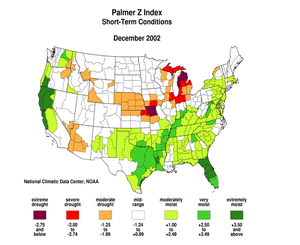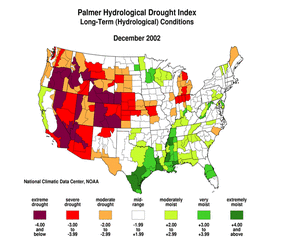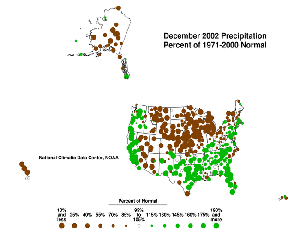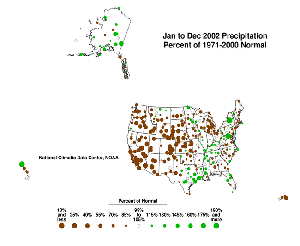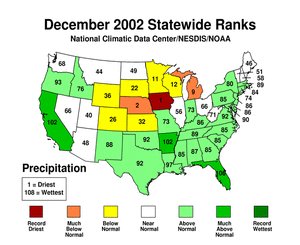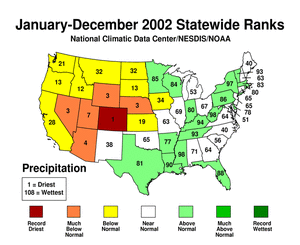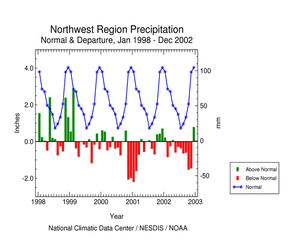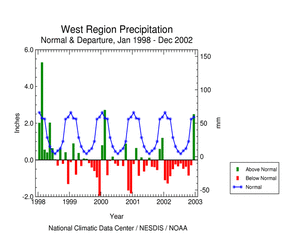U.S. Drought Highlights:
- On the national scale, severe to extreme drought affected about 22 percent of the contiguous United States as of the end of December 2002
- moderate to extreme drought affected about 35 percent of the contiguous U.S.
- Short-term conditions continued to improve across parts of the western U.S. yet long-term deficits persist
- Short and long-term conditions continued to improve over the east coast
- Much of the region from the central Plains to the northern Great Lakes suffered from short-term drought, which worsened long-term drought conditions in some areas
Please Note: The data presented in this drought report are preliminary. Ranks, anomalies, and percent areas may change as more complete data are received and processed.
National Overview
On the national scale,
- about 35 percent of the contiguous U.S. fell in the moderate to extreme drought categories (based on the Palmer Drought Index) at the end of December;
- severe to extreme drought affected about 22 percent of the contiguous United States as of the end of December 2002;
- this is the fifth consecutive month of decreasing areal coverage of drought
- the coverage of the current (November 1999-present) national-scale drought first peaked in August 2000 at about 36% of the contiguous U.S., which was as extensive as the major droughts of the last 40 years, but not as large as the "dust bowl" droughts of the 1930s and 1950s;
- the total drought area decreased to about 10 percent by November 2000, but had a general increasing trend for much of the period since then, reaching in July 2002 the peak it had first reached in August 2000 (see graph below left);
- on a broad scale, the last two decades were characterized by unusual wetness with short periods of extensive droughts, whereas the 1930s and 1950s were characterized by prolonged periods of extensive droughts with little wetness;
- although various parts of the U.S. have experienced unusually wet conditions during the last 38 months, little change occurred in the aggregate national wetness picture during much of this period;
- the percentage of the nation severely wet has remained below about eleven percent during this period, reaching about 7 percent by the end of December 2002;
- a file containing the national monthly percent area severely dry and wet from 1900 to present is available;
- historical temperature, precipitation, and Palmer drought data from 1895 to present for climate divisions, states, and regions in the contiguous U.S. are available at the Climate Division: Temperature-Precipitation-Drought Data page in files having names that start with "drd964x" and ending with "txt" (without the quotes).
Although some areas of the country were very dry this month, much of the southern, eastern, and coastal western U.S. was wet. Integrated across the nation, December 2002 precipitation averaged well above normal.
Regional Overview
December 2002 was wet across much of the southern and eastern U.S., and heavy rain and snow fell across parts of the west coast. The 2002 drought areas in the Northeast and Southeast have received much-above normal precipitation during the last several months, with mainly just long-term hydrological deficits remaining.
The month was unusually dry across parts of the central Plains to northern Great Lakes, compounding a dry pattern that continued from November.
December was drier than normal at most of the primary stations in Alaska, Hawaii, and Puerto Rico.
These overall conditions are evident in the following indicators:
- the runoff, evaporation, and soil moisture conditions as calculated by the National Weather Service,
- maps showing the percent of normal precipitation for airport stations for the current month and year-to-date,
- the percent of average precipitation map for December (as of January 1, 2003) for the SNOTEL stations in the western mountains provided by the USDA Water and Climate Center,
- the percent of average snow water content map for December (as of January 1, 2003) for the SNOTEL stations in the western mountains provided by the USDA Water and Climate Center,
- the statewide precipitation ranks for current month (short-term) and 3-months, 6-months, and 12 months (longer-term), and
- the short-term surface wetness anomaly map for December computed by the National Climatic Data Center from the Special Sensor Microwave Imager (SSMI), a polar orbiting satellite with global coverage, and
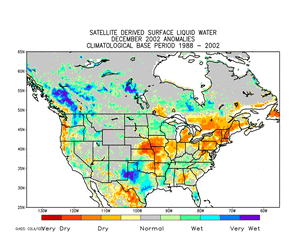
Satellite-based North America
surface wetness anomalies
The surface wetness anomaly map shows areas of
above and below average liquid precipitation
wetness. During the winter months, it should be used
in conjunction with the snow cover anomaly map.
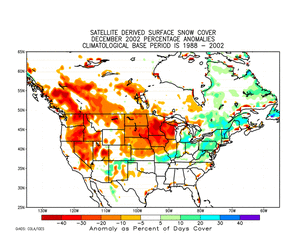
Satellite-based North America
snow cover anomalies
The snow cover anomaly map shows areas of
above and below average frozen precipitation
"wetness". An area with above-average snow
cover may appear to have below-average
liquid wetness.
- the USGS December daily streamflow maps.
Western U.S. Drought
A series of Pacific storms brought above-normal rain and snow to much of the west coast during December. California's Sierra Nevada benefitted significantly from the November and December snows, but the wetness dropped off to the north and east, with some parts of the interior Far West experiencing moderate drought this month.
Significant long-term moisture deficits remain, however. Several states had the tenth driest, or drier, year in 2002 with Colorado ranking as the driest in the last 108 years. Long-term drought, below-normal mountain snowpack, and depleted reservoirs remained a serious concern across much of the Far West.
A detailed review of drought conditions is available for the following regions and states:
- Pacific Northwest region
- West region
- Southwest region
- Arizona
- Colorado
- Idaho
- Montana
- Nevada
- New Mexico
- Oregon
- Utah
- Washington
- Wyoming
Central U.S. Drought
December was dry across much of the central Plains to northern Great Lakes region. This is reflected both by below-normal precipitation amounts as well as deficient snow cover and drier-than-normal soil moisture in the upper and lower soil layers. This month ranked as the driest December on record, statewide, for Iowa and second driest for Nebraska. When the December dryness is combined with the unusual dryness of November, four states rank as having the driest or second driest November-December on record.
The November-December dryness exacerbated conditions in the central and northern Plains states, which have experienced drought for much of the year. Severe to extreme long-term (hydrololgical) drought intensified over parts of the central Plains and developed over parts of the Great Lakes.
A detailed discussion of drought conditions is available for the following regions and states:
- East North Central region
- West North Central region
- Illinois
- Iowa
- Kansas
- Michigan
- Minnesota
- Missouri
- Nebraska
- North Dakota
- South Dakota
- Wisconsin
Eastern U.S. Drought
December marked the fourth consecutive wet month across much of the former drought areas of the Northeast and Southeast regions. The drought recovery was reflected in stream levels and moist topsoil conditions. However, although ground water levels were recovering, they were still below average in many locations. Long-term precipitation deficits remained from parts of Georgia to Virginia and across much of Maine.
A detailed discussion of drought conditions is available for the following regions and states:
 NOAA's National Centers for Environmental Information
NOAA's National Centers for Environmental Information
